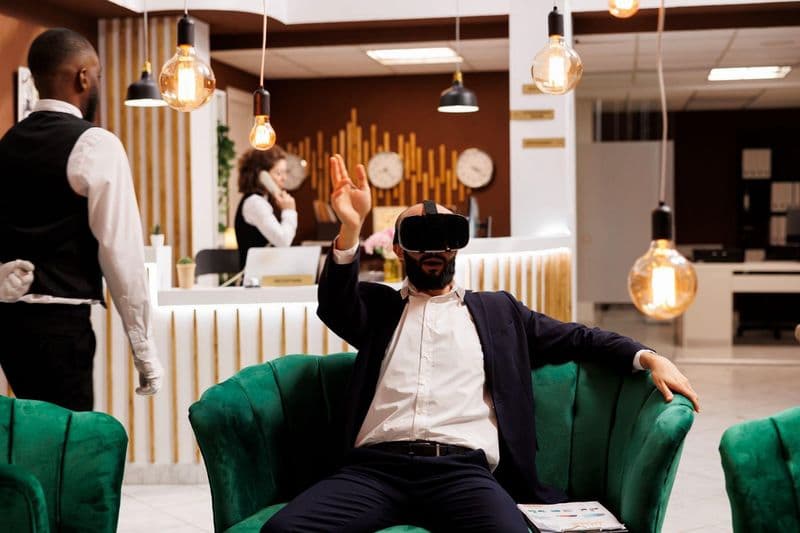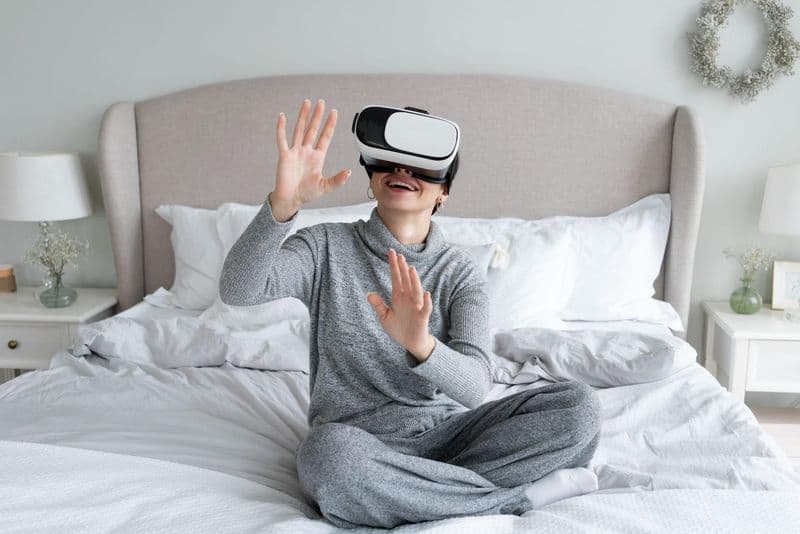Augmented Reality in Hotels: Enhancing the Hospitality Industry
Imagine checking into a hotel where your phone instantly guides you to your room through virtual arrows on the floor, or scanning a menu to see a 3D preview of dishes. For senior travelers visiting new hotels or unfamiliar destinations, this technology can be especially valuable; it helps them easily navigate layouts, locate amenities, and feel more confident and comfortable during their stay. This isn't futuristic fantasy; it's the power of Augmented Reality (AR) in hospitality.
Leading hotels are already adopting AR to elevate guest experiences, streamline operations, and create unforgettable stays. By projecting digital elements with the real environment, AR is transforming how guests explore, interact, and engage with hotel spaces.
What is Augmented Reality in Hotels?
Augmented Reality (AR) in hotels refers to the integration of interactive digital elements such as 3D visuals, navigation cues, and virtual overlays into real-world hospitality environments. Unlike Virtual Reality (VR), which immerses users in a completely digital space, AR enhances the guest's real-world experience by layering virtual content onto physical surroundings.
AR tools use smartphones, tablets, or smart glasses to transform how guests interact with spaces and services. From AR-guided check-ins and interactive room tours to 3D restaurant menus and virtual concierge services, these tools help hotels enhance convenience, engagement, and personalization.
Key Features of AR in Hotels
Virtual Tours: Guests can explore rooms, amenities, and nearby attractions through immersive 3D previews before booking or during their stay.
Interactive Navigation: AR wayfinding guides guests through the hotel, showing directions to restaurants, spas, or conference halls directly on their screens.
Maintenance Updates: Staff can use AR tools to visualize equipment issues or receive step-by-step repair instructions, improving efficiency and response time.
Personalized Offers: Guests can point their phones at objects or areas (like a bar or spa) to instantly view exclusive deals, event schedules, or loyalty rewards.
In-Room Entertainment: AR brings walls, menus, and decor to life. Guests can scan posters for animated stories, play AR games, or access virtual concierge services.
How Augmented Reality is Changing the Hotel Industry

Augmented Reality (AR) is transforming the hospitality landscape by blending digital experiences with real-world environments. From booking and navigation to personalized service and entertainment, AR is redefining how guests interact with hotels and how hotels deliver value.
Key Stats on AR in Hospitality
The global AR and VR market in the hospitality industry is projected to grow at a CAGR of 34.2% from 2022 to 2028.
The AR in the travel and tourism market is expected to expand from US $21.44 billion in 2024 to US $108.47 billion by 2029 (CAGR ≈ 38.6%).
64% of hotel guests say AR enhances their engagement and decision-making when exploring hotel facilities.
The AR market in hospitality is projected to grow by over 40% by 2030, fueled by demand for personalization and immersive experiences.
Impact of AR on the Hotel Industry
Enhanced Guest Engagement: AR turns ordinary interactions into immersive experiences, allowing guests to explore rooms, amenities, and local attractions in engaging new ways.
Personalized Experiences: Hotels use AR to deliver tailored offers, interactive menus, and room features based on guest preferences.
Streamlined Operations: Maintenance teams and staff can use AR for real-time troubleshooting, equipment visualization, and guided repairs, reducing downtime and costs.
Innovative Marketing: AR-powered campaigns allow hotels to showcase their spaces, services, and brand story in more captivating ways, driving bookings and social media buzz.
Improved Training & Efficiency: AR simulations help staff learn complex tasks in realistic environments, boosting skill and confidence without interrupting service.
Increased Guest Satisfaction: By combining convenience, interactivity, and personalization, AR creates memorable stays that strengthen brand loyalty and repeat visits.
Key Benefits of Augmented Reality in Hotels
- Immersive Guest Experiences: AR transforms standard stays into interactive adventures, letting guests explore amenities, view destinations, and access real-time information.
- Personalized Engagement: Guests enjoy tailored offers, local insights, and digital interactions that adapt to their preferences and behavior.
- Stronger Brand Identity: AR-driven storytelling, virtual campaigns, and creative visuals help hotels differentiate themselves and appeal to modern travelers.
- Smarter Operations: Staff can rely on AR for guided maintenance, digital checklists, and visual training modules, improving accuracy and speed.
- Higher Booking Confidence: Interactive previews of rooms and facilities help guests make faster, more informed booking decisions.
- Long-Term Guest Loyalty: Tech-enhanced experiences create memorable stays that encourage repeat visits and positive word-of-mouth.

Applications and Use Cases of AR in Hotels
Virtual Room Previews and Booking Tools
Before making a reservation, potential guests can use AR apps or mobile browsers to visualize rooms on a real scale. By scanning a brochure, website image, or QR code, they can view a 3D projection of the room layout, furniture, and décor directly in their environment.
This helps guests understand size, ambiance, and view. Guests sitting at home can scan a hotel's Instagram post and instantly see a life-sized 3D model of the suite on their living room floor.
In-Room Customization and Interactive Features
After check-in, AR can personalize the stay. Using tablets or smartphones, guests can adjust lighting or artwork virtually, view step-by-step tutorials for appliances, or scan surfaces to unlock digital menus and concierge services. Scanning the minibar shows detailed drink info and personalized recommendations, or scanning the wall art reveals the artist's story in 3D animation.
AR Navigation and On-Site Wayfinding
Large properties and resorts use AR navigation to simplify movement through complex spaces. Guests open the hotel's mobile app, point their camera, and follow digital arrows or floor markers overlaid on their surroundings. An AR overlay leads a guest from the lobby to the spa, showing pop-up info about facilities along the route.
Personalized Recommendations and Real-Time Offers
Hotels can link AR experiences to guest data or location. When guests point their device toward a specific area (like the pool or restaurant), the system triggers context-based offers, event invites, or loyalty rewards. A guest scanning the bar menu sees an animated cocktail guide plus a pop-up discount for happy hour.
Historical Destinations and Local Exploration
Hotels extend AR beyond their walls to connect guests with local attractions. Guests can scan a map, brochure, or nearby landmark to reveal interactive guides, historical overlays, and 3D models of destinations. While standing on a balcony, guests can hold up their phone to see labeled AR overlays identifying mountains, landmarks, or cultural sites nearby.
Guest Engagement and Gamified Experiences
AR transforms exploration into fun, memorable activities. Hotels can create scavenger hunts, trivia games, or digital art trails that encourage guests to interact with spaces and share experiences online. Families can go for an AR "treasure hunt," where scanning murals or objects around the hotel reveals clues and prizes, boosting both engagement and social media sharing.
Maintenance, Housekeeping, and Staff Training
Beyond guest use, AR helps staff perform operational tasks more efficiently. Maintenance teams can visualize hidden wiring or plumbing through AR overlays, while housekeeping staff receive digital checklists visible through smart glasses or tablets. A good example of this is a technician using a device at an air-conditioning unit to view virtual repair instructions superimposed over the equipment.
Event and Conference Enhancement
Hotels hosting events can use AR to improve attendee navigation and engagement. Attendees can scan signs to view interactive schedules, sponsor content, or 3D visual aids during presentations. For instance, scanning a conference poster displays a 3D event map and live session info directly on the attendee's phone screen.
Real-World Examples of AR in Hotels
Holiday Inn London Kensington Forum – AR Athlete Experience
During the 2012 London Olympics, Holiday Inn introduced an AR feature that allowed guests to view virtual athletes performing various sports inside the hotel using their smartphones. The campaign showcased how AR can make hospitality experiences engaging and event-driven.
Premier Inn Hub Hotel (UK) – Interactive Wall Maps
Premier Inn's Hub Hotel added an AR-enhanced city map in guest rooms. When scanned with a smartphone, the map displayed nearby attractions, restaurants, and travel routes, helping guests explore the city effortlessly from their room.
Shangri-La Hotels – AR Concierge and Room Features
Shangri-La enhances in-room experiences with AR-based digital guides. Guests can scan surfaces or brochures to access interactive concierge services, spa recommendations, and virtual entertainment options.
Hyatt Hotels – Smart Room Customization via AR
Hyatt is experimenting with AR apps that allow guests to adjust lighting, temperature, and entertainment options using digital overlays on their smartphones.
Challenges of Augmented Reality in Hotels
While Augmented Reality in the hotel industry offers exciting opportunities for guest engagement, hotels face several practical and operational hurdles in implementing it effectively:
High Implementation Costs
Developing custom AR experiences, integrating them into apps, and maintaining the technology requires significant investment. The cost is exceptionally high for independent, boutique, or mid-scale hotels.
Technical Compatibility
AR applications rely on stable Wi-Fi, modern devices, and updated operating systems. Guests using older phones or poor network connections may experience glitches or limited functionality.
Staff Training and Adoption
Frontline hotel staff need proper training to guide guests through AR tools and troubleshoot issues. Without awareness and confidence, the technology may go underutilized.
Content Maintenance
AR experiences must be continuously updated to reflect room changes, local events, or seasonal promotions. Outdated visuals or broken links can frustrate users and damage brand perception.
Data Privacy Concerns
AR systems often use location data and behavioral tracking. Ensuring compliance with privacy laws and maintaining guest trust is essential.
The Future of Augmented Reality in Hotels
As AR technology becomes more affordable and accessible, its role in the hospitality industry is expected to expand significantly. Future developments may include:
Smart AR Navigation: Guests could use AR-powered glasses or phones to navigate large properties. Guests can use it to find rooms, restaurants, or meeting halls through guided digital overlays.
Personalized Guest Experiences: AR will increasingly use data analytics to customize visuals, offers, and in-room suggestions based on guest preferences and travel history.
Enhanced Virtual Marketing: Destination marketers will leverage AR to create immersive previews of hotel amenities, allowing travelers to "walk through" suites or conference halls before booking.
Integration with IoT and AI: AR combined with Internet of Things devices and AI assistants will enable real-time personalization, such as adjusting lighting, temperature, or entertainment through visual commands.
Sustainability and Training Applications: Hotels may use AR to reduce printed materials (like menus and brochures) and train staff through realistic, interactive simulations instead of traditional manuals.
AR Photobooths and Social Sharing: Digital props and fun filters for selfies in lobbies or event spaces will encourage guests to share their experiences on Instagram or TikTok, blending entertainment with organic marketing and advertising.
AR for Accessibility and Senior Comfort: AR navigation tools can help senior guests easily find their rooms, elevators, or amenities through on-screen guidance or voice-supported overlays. Virtual previews of the property before arrival also reduce confusion and boost travel confidence.
Conclusion
Augmented Reality is reshaping the hotel experience by blending digital interaction with real-world hospitality. From virtual tours to personalized in-room features, AR helps hotels engage guests in more immersive and meaningful ways.
While cost and technical barriers exist, its growing accessibility makes AR a powerful tool for enhancing guest satisfaction and giving hotels a modern, competitive edge.
Reach and inspire potential guests like never before with immersive pre-booking visualization. Create captivating virtual experiences with Flam that bring your suites, amenities, and unique ambiance to life and drive real-world room reservations.